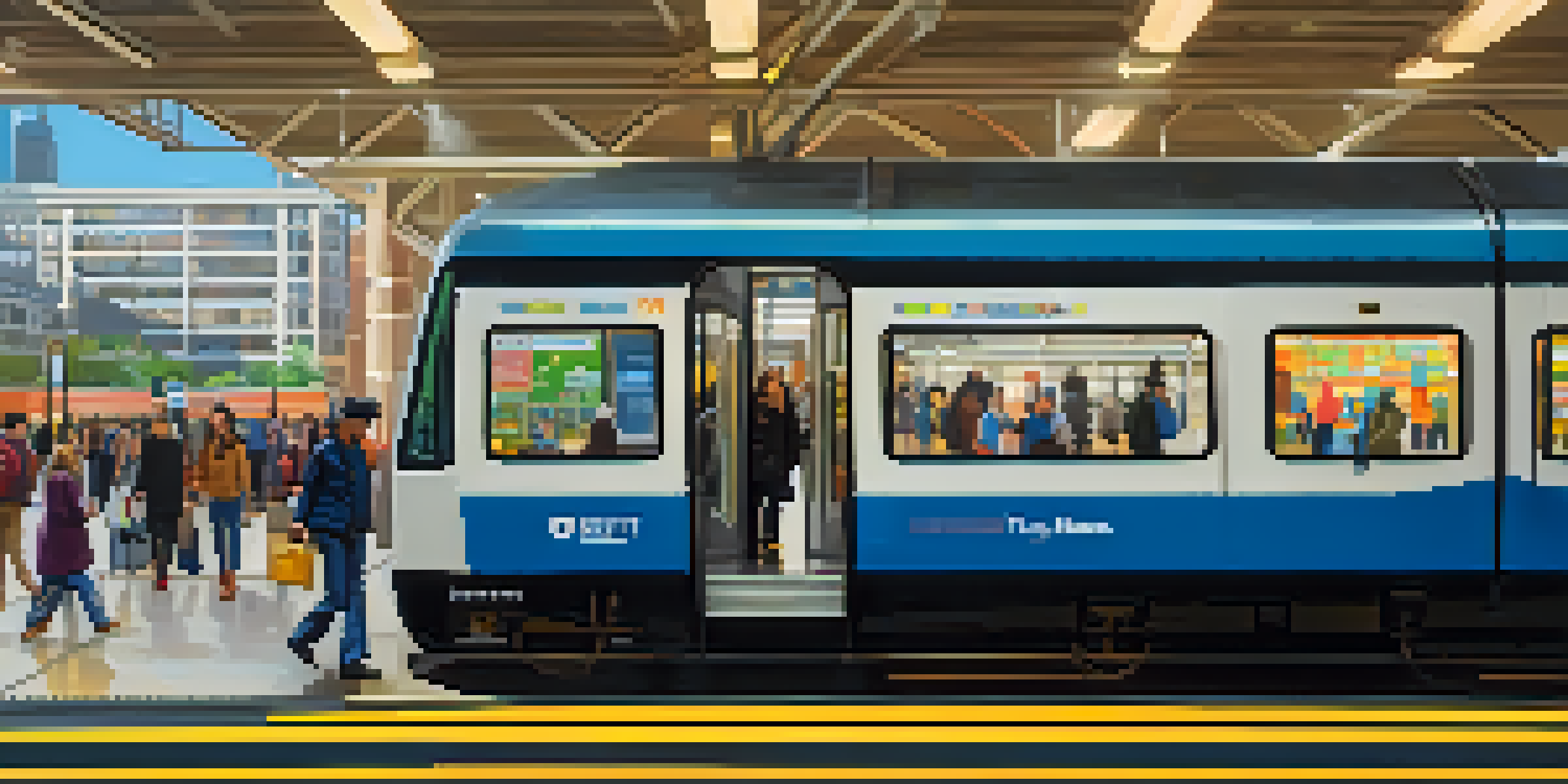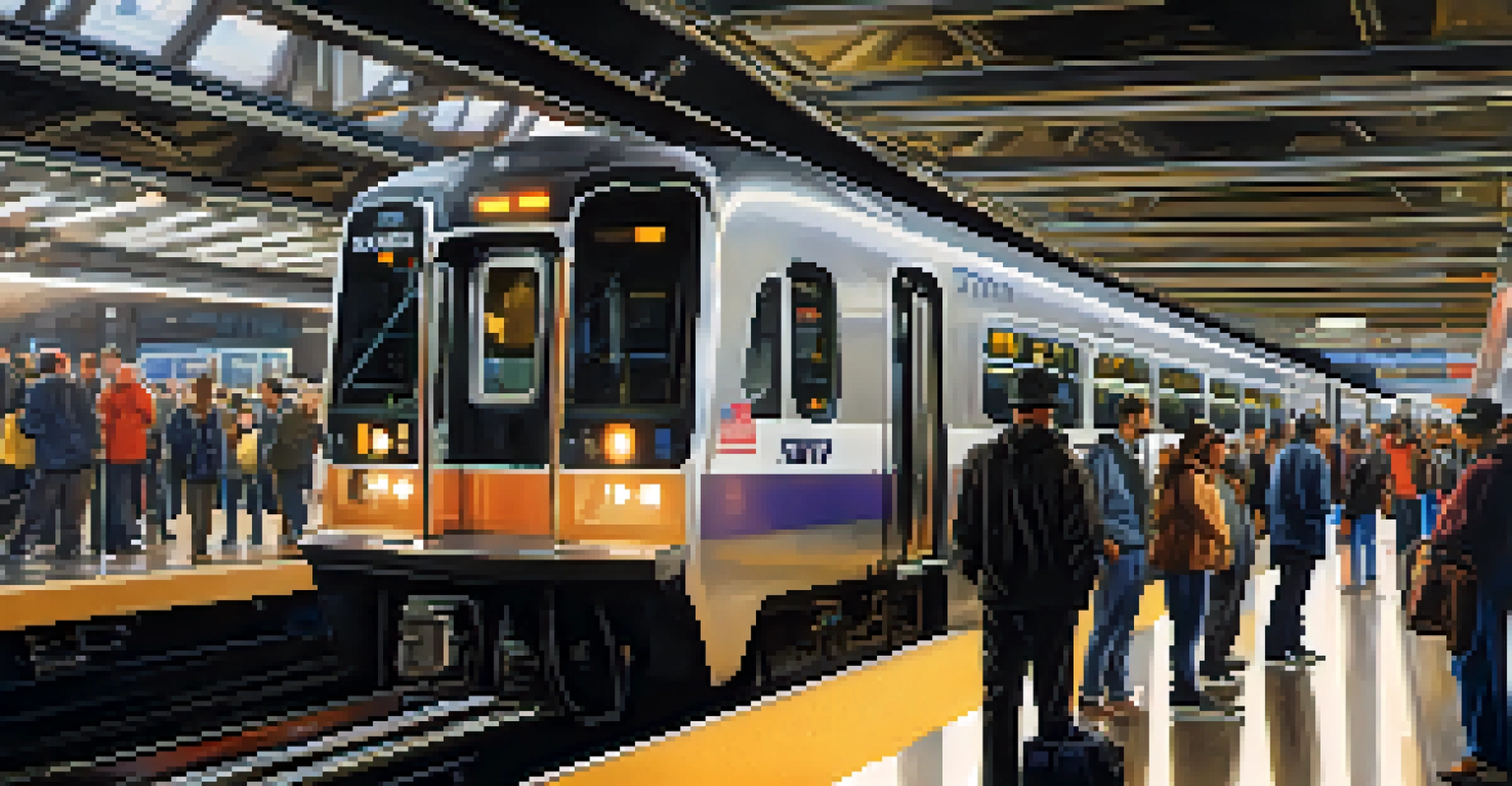How Jersey City's Transit Options Compare with Nearby Cities

An Overview of Jersey City's Transit System
Jersey City's transit system is a bustling hub of activity, connecting residents to New York City and beyond. With options like the PATH train, NJ Transit, and light rail, commuting here is both convenient and efficient. For those who rely on public transportation, the frequency of these services can be a game changer, allowing for flexible travel times throughout the day.
Public transportation is the backbone of a city, connecting people to jobs, education, and opportunities.
The PATH train is perhaps the crown jewel of Jersey City's transit, offering a swift ride to Manhattan in just about 15 minutes. Meanwhile, NJ Transit services provide connections to other parts of New Jersey, making it easy for commuters to access jobs and education. Additionally, the Hudson-Bergen Light Rail adds a local touch, connecting neighborhoods to key destinations within the city.
Overall, Jersey City's transit options are designed to cater to a diverse population, from daily commuters to occasional visitors. The city's focus on improving public transport reflects its commitment to making travel accessible for everyone. As we delve deeper, let's see how these options compare with those available in nearby cities.
Transit Options in Hoboken: A Close Comparison
Hoboken, just a stone's throw from Jersey City, offers its own unique blend of transit options. Much like Jersey City, Hoboken is served by the PATH train, making it a popular choice for commuters heading to Manhattan. However, Hoboken also boasts the Hoboken Terminal, a major hub for NJ Transit trains that extend to various parts of New Jersey.

Additionally, Hoboken's ferry services provide a scenic and efficient way to reach Manhattan, allowing for a leisurely commute across the Hudson River. This option not only provides a beautiful view but also helps to avoid the hustle and bustle of train stations. The convenience of having multiple transit methods makes Hoboken an appealing choice for those who want flexibility.
Jersey City's Transit Options Flourish
Jersey City's transit system, featuring the PATH train and light rail, efficiently connects residents to Manhattan and other destinations.
In terms of walkability, Hoboken shines as well, with most amenities and transit options just a short stroll away. While Jersey City has its strengths, Hoboken's combination of ferry service and train access gives it a slight edge in terms of variety. As we continue, let’s examine what Newark has to offer in comparison.
Newark's Transit Landscape: A Broader Perspective
Newark's transit system is robust, featuring an extensive NJ Transit network that connects the city to multiple regions. The Newark Penn Station serves as a central hub, offering connections to Amtrak, PATH, and NJ Transit trains, making it one of the busiest transit points in the state. This level of connectivity makes Newark an important player in New Jersey’s public transportation scene.
A city’s transit system should be seen as a living organism, adapting to the needs of its community.
Unlike Jersey City, Newark has a wider array of bus services, which can be beneficial for those who need to get to less accessible areas. With its focus on enhancing public transport, Newark is investing in improvements, aiming to create a more seamless experience for commuters. This could mean more frequent bus routes and better integration with train services in the near future.
Moreover, Newark's proximity to the Newark Liberty International Airport adds another layer of convenience for travelers. While Jersey City excels in its quick access to Manhattan, Newark offers a different strength with its significant transportation network. Now, let’s take a look at how these cities compare to a commuter favorite like Weehawken.
Weehawken's Scenic and Efficient Transit Options
Weehawken, known for its stunning waterfront views, provides a unique transit experience. While it may not have as many train options as Jersey City or Newark, the Weehawken ferry service offers a picturesque commute to Manhattan. This ferry ride is not only quick but also a delightful way to enjoy the skyline during your travels.
In addition to the ferry, Weehawken residents can also access NJ Transit buses that connect to local train stations, allowing for easy transfers. This combination of transit methods allows for flexibility, especially for those who work in different areas of the city. The focus on maintaining a reliable and scenic transit option makes Weehawken attractive for both residents and visitors alike.
Comparative Edge of Hoboken's Transit
Hoboken's unique transit options, including ferry services and a major NJ Transit hub, offer added flexibility for commuters compared to Jersey City.
It's important to note that while Weehawken may not have the same extensive rail network as Jersey City, its unique offerings make it a competitive choice. The emphasis on scenic travel resonates with many who prioritize experience alongside efficiency. Now, let's shift our focus to how these transit options impact daily commuters in Jersey City.
Daily Commuting in Jersey City: What to Expect
For many residents, daily commuting is an integral part of life in Jersey City. Thanks to the efficient transit options available, most commuters can expect a reasonable travel time to Manhattan, averaging around 30 minutes. This accessibility has been a significant factor in the city's growth, attracting more people to live and work here.
Jersey City's diverse population means that transit needs vary widely, from early risers to night owls. The PATH train's frequent service caters to those varied schedules, ensuring that everyone can find a suitable option. Furthermore, the light rail system also plays a crucial role in helping residents travel within the city, connecting neighborhoods to job centers and recreational spots.
However, like any urban transit system, challenges can arise, especially during peak hours. Crowded trains and delays can be frustrating, but the city is actively working on improvements to enhance the commuter experience. Understanding these dynamics can help potential residents weigh their options when considering a move to Jersey City.
The Impact of Transit on Local Economy and Growth
Transit options play a vital role in shaping the local economy and development of Jersey City. With easy access to Manhattan, many businesses are drawn to the area, recognizing the talent pool that comes from having reliable transit. This influx of companies not only creates jobs but also boosts the local economy, leading to a vibrant community.
Moreover, the growth of transit-oriented development, where residential and commercial spaces are built near transit hubs, is becoming increasingly popular. This strategy not only maximizes convenience for residents but also encourages sustainable living by reducing reliance on cars. As a result, Jersey City is seeing a transformation that aligns with modern urban living trends.
Future Growth in Transit Infrastructure
Jersey City is actively planning transit expansions and innovative solutions to meet the growing needs of its population and economy.
However, with growth comes the need for continued investment in transit infrastructure. Addressing the demands of a growing population requires ongoing upgrades and expansions to the existing systems. In this way, Jersey City's transit options are not just a means of getting from point A to point B; they are foundational to the city's future prosperity.
Future Developments in Jersey City Transit Options
Looking ahead, Jersey City is poised for exciting developments in its transit infrastructure. Planned expansions for the PATH train and light rail systems aim to enhance connectivity within the city and to neighboring areas. These improvements reflect a commitment to meeting the needs of an increasing population and fostering economic growth.
Additionally, the city is exploring innovative transit solutions, such as increased shuttle services and bike-sharing programs. These options not only promote environmentally-friendly travel but also address the challenges of congestion and parking. As cities worldwide rethink transportation, Jersey City is on the cutting edge of these trends.

Community engagement is also critical in shaping the future of transit in Jersey City. By involving residents in the planning process, the city can ensure that developments align with the needs of the community. As we wrap up our comparison, it's clear that Jersey City's transit options are evolving to meet modern demands, setting the stage for continued growth.